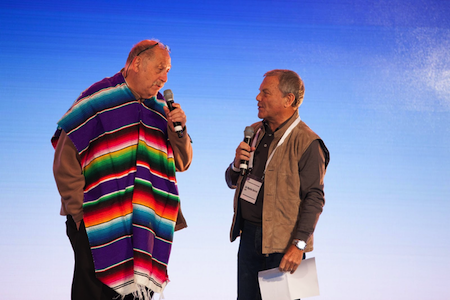Fuel campaign performance with laser-focused targeting

I was one of the lucky few to attend WPP's invitation-only "Un-conference," Stream that took place in Ojai CA between November 16 th and 19th, 2016. Hosted by Sir Martin Sorrell and Yossi Vardi, the event attracted the best and brightest minds in advertising. Having traveled all the way from Bengaluru, India unsure of what to expect from an "un-conference," I was intrigued. Among the participating luminaries were Sheryl Sandberg from Facebook, Imran Khan from SnapChat, Ben Silbermann from Pinterest, Adam Bain from Twitter, and Anne Wojcicki from 23andMe. Brand attendees included Nestle, Diageo, Nike, Bank of America, Unilever, and more.

The event was unique not just for the attendee-initiated discussion topics but also for additional activities such as yoga, meditation and a cooking contest in addition to offbeat activities such as powerpoint karaoke and VR tech garden. Added to this, an unexpected drop in temperatures prompted the purchase of Mexican ponchos readily procured by the resourceful organizers, resulting in a colorful gathering of attendees indeed! Used to the more temperate climate of India, I promptly donned a poncho, grateful for its warmth!
The discussions at Stream covered a spectrum of thought-provoking topics such as Artificial Intelligence, Parenting in the Digital Age, Why Hillary lost the Election, The Future of the Advertising Agency and Corporate Transparency. One prevalent theme was the importance of trust in advertising and the changing definition of what that means. How do brand advertisers trust that each of their media partners is working in their best interest?
The topic was not just limited to measurement and metrics although that was certainly front and center. Facebook addressed the revelation that they made an error in the measurement of video viewership overstating time spent on videos on their platform for over 2 years. They subsequently found additional errors in audience measurement across a portfolio of products, admitting additional work/investment was required to give advertisers and agencies "clarity and confidence" in their walled garden environment. SnapChat shared that they decided not to take the walled-garden approach by implementing a host of third party measurement partners - 16 and counting!
Indeed the list of measurement solutions to meet advertiser requirements is long and growing. Fraud protection, brand safety, audience verification and viewability measurement are all pre-requisites and offer multiple choices of vendors for each standard. We, at InMobi, have changed ad serving impressions to count on ads rendered only when those impressions are from human traffic, in a brand safe environment, with the ad 100% in view for a certain length of time, sometimes with audio on.. In one discussion group, it was estimated that over 10% of the cost of digital media (and maybe as much as 20%) is attributed to providing trust assurances.

A couple of dominant topics at Stream suggest that there are two new areas of trust that need to be addressed - fake content and bias in advertising. Concerns around misleading and fake social media content having a major influence on how Americans voted in the recent US Elections was a big topic. As self-defined "technology" companies, not "media" companies, editorial oversight was not something that either company had contemplated. That will likely change.
Perhaps one of the most fascinating and well-attended discussions was led by Joel Benenson, Hillary Clinton’s pollster, who spoke about the results of the US Election. Part analysis and part therapy, the conversation was centered on how Americans were blindsided by the election results because their individual experiences on social media mirrored their individual points of view. This raised many questions around the topic of bias in marketing - especially models that are inaccurately built based on confirmation bias. What are the causes of bias in marketing? How does an ad agency and/or tech company ensure that the talent they employ is diverse enough that human bias is limited? Even as we start to employ new technologies such as Artificial Intelligence, concerns arose on whether bias was baked into machines or not.

Whether the cost of trust is 10% or 20%, perhaps a more fundamental question is how do large media partners like InMobi ensure that the cost of trust isn’t innovation itself? Are we investing more in supporting third party verification services than we are in innovation? As the head of a mobile advertising platform, the need to balance these two is especially poignant given the juxtaposition of a highly personal device and rapidly changing consumer behavior. Media companies need to build a foundation of trust with their advertising partners to continue to innovate for and with them. How are we able to continue to test in new areas when third party verification services aren’t yet available? Could this hold back innovation? Constant innovation and disruption are two of the principles of digital marketing and finding ways for these to co-exist with today’s trust standards will be key.
It was certainly plenty to think about as I boarded the flight for home. I look forward to seeing what next year’s Stream has in store and I will definitely carry my poncho!
Register to our blog updates newsletter to receive the latest content in your inbox.